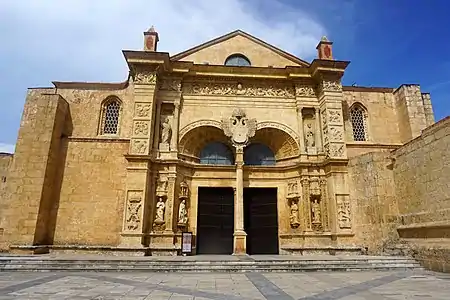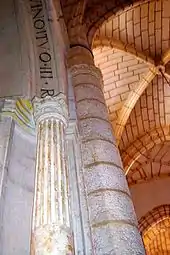Basilica Cathedral of Santa María la Menor
The Cathedral of Santa María la Menor in the Colonial City of Santo Domingo is dedicated to St. Mary of the Incarnation. It is the oldest cathedral in the Americas, begun in 1514 and completed in 1541.[1] It is the Cathedral of the Archbishop of Santo Domingo who has the honorary title of Primate of the Indies because this cathedral was the first Catholic diocese and the oldest cathedral established in the New World.[2]
| Cathedral of Santa María la Menor | |
|---|---|
 Front entrance to the Cathedral of Santa María la Menor | |
| Religion | |
| Affiliation | Roman Catholic |
| Province | Archdiocese of Santo Domingo |
| Location | |
| Location | Santo Domingo, Dominican Republic |
| Architecture | |
| Style | Gothic |
| Groundbreaking | 1514 (1521 actual building work start) |
| Completed | 1541 |
| Part of | Colonial City of Santo Domingo |
| Criteria | Cultural: (ii), (iv), (vi) |
| Reference | 526 |
| Inscription | 1990 (14th session) |
| Coordinates | 18°28′22″N 69°53′02″W |
 Location of Basilica Cathedral of Santa María la Menor in the Dominican Republic | |
The Cathedral is fronted with a golden-tinted coral limestone façade. The building is mainly Gothic,[1][2] one of the scarce examples of real Gothic architecture outside Europe. There is also a treasury which has an excellent art collection of ancient woodcarvings, furnishings, funerary monuments, silver, and jewelry.
It is located between Calle Arzobispo Merino and Isabel la Católica, next to Columbus Park in the city of Santo Domingo de Guzman.
History
The Cathedral was commissioned by Pope Julius II in 1504 and its construction began in 1512 under the leadership of Bishop Fray García Padilla. The arrival of Bishop Alexander Geraldini in 1519 motivated the construction of a temple of greater solemnity, so it was decided to build the current church, whose foundation stone was laid in 1521. The construction was carried out by Luis Moya, according to plans designed by Alonso Rodriguez, of Seville, Spain. By 1523, the construction achieved continuous progress until its consecration in 1541. On February 12, 1546, at the request of Emperor Charles V, Pope Paul III granted the status of Metropolitan Cathedral and Primate of the Americas. Francis Drake when he captured the city in 1586, used the cathedral as his headquarters and saved it from destruction. It was also the headquarters of the Archdiocese of Santo Domingo, which bore the aforementioned title of Primate. In 1920, Pope Benedict XV designated the Cathedral a Minor Basilica in his Inter Americae.
Architecture
The first noticeable feature of the structure are the solid limestone walls and three doors, two of which are gothic and the third main door which is plateresque. There are twelve side chapels, three aisles and a nave. The roof of the nave is pitched, while the aisles have cross vaulted ceilings. The length of the basilica is 54 metres (177 ft), the width of each of the three aisles is 23 metres (75 ft), the height to the vaulted ceilings is 16 metres (52 ft) and the total area is 3,000 square metres (32,000 sq ft). All of the side chapels were not included in the original footprint of the building, rather they were appended with time.
The cathedral has a treasury containing retablos, paintings, old woodwork, furniture, sculptures and tombstones. There are pieces that were involved with the funeral proceedings of several colonial archbishops. There is a tombstone of Simon Bolivar, one of the ancestors of the Liberator Simon Bolivar. Of note, the remains of Christopher Columbus were once housed at the cathedral, before their final resting place in the Faro a Colon.
Gallery
See also
References
- "Basilica Cathedral of Santa María la Menor". 5albemarleway.co.uk. 15 August 2018.
- "Colonial City of Santo Domingo". UNESCO World Heritage Centre website.
External links
| Wikimedia Commons has media related to Catedral Santa María La Menor, Santo Domingo. |
- Flores Sasso, Virginia de los Ángeles (2012), Doctoral Thesis about the construction of Santo Domingo's Cathedral (in Spanish).











